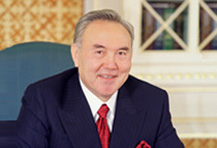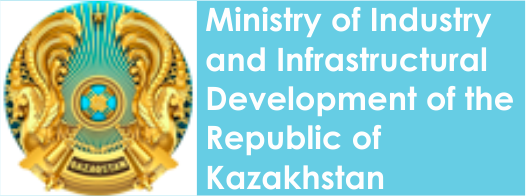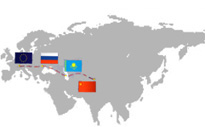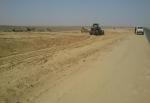GREAT SILK WAY!
DID SUCH ROAD EXIST IN REALITY AND WHERE DID IT PASS?
Roads… Roads uniting fortunes, cultures, civilizations. Whose footstep had first left his print on those nameless caravan paths which later joined the impetuous riverbed of “Great Silk Way”?
Great Silk Way creates in everybody’s imagination caravans full with exotic goods, which passing through sultry deserts and mountain steeps, subjected to the danger for several months moved steadily from mysterious South-Eastern Asia’s countries to the flourishing and rich cities of Near East and Middle East, Mediterranean and further to Europe. The caravans also passed in opposite direction.
Entire people passes away from the historical arena, cities perished, old caravan paths were covered with sand. But new trade ways appeared on the vast desert and steppe territories of southern part of the Eurasian continent. Southern shipping lane functioned along the coastal seas of the Indian and Pacific oceans.
Written sources of the antic period (5-6 centuries BC) indicate the trade trips of ancient Greeks and Romans to the Middle Asia. Itineraries – road lists have been preserved where the description of ways, road stations (staphms) were written, distance between settlements was shown. Prestige “tsar roads” and local routes of the most important meaning, leading from the cities of Greek-Roman world to the remote Eastern peoples have been mentioned in these “guide books”.
The intensity of the transit trade on the Great Silk Way gradually moves to the southern shipping lanes.
Medieval civilization owes “The Great Silk Way” not only knowledge about silk manufacturing, but the main technologies of paper, China, glass production, book printing distribution. Eastern philosophy influenced greatly over the European natural sciences too.
RESTORATION OF THE SUPER CONTINENTAL ANCIENT ROUTE
Why are we so interested in this ancient trade route? First of all, that route connected unique and inimitable civilizations of East and West through the material and spiritual values exchange during twenty centuries. Global trends of modern civilization have been characterized by powerful movement of countries and people to the integration. And even disintegration of some artificial national formations based on the struggle for equal rights further leads to the approaching and mutual cooperation. Preservation and enrichment of the peoples’ cultural originality is the base and result of the overall world progress. Understanding, that the base of this progress had been laid not only in Europe, Mediterranean or Asian continent, but it was created by the efforts of all humanity, have been strengthened in the world.
Previous experience allows better understanding of each other, feeling of civilization development succession, enduring time and peoples’ fortune connection. Thus, the Great Silk Way is one of the most ancient integration models of human community development..
XXIV session of the General Assembly of UNESCO by ten countries’ initiative, including Soviet Union, adopted the resolution about organization and on a large scale execution of the humanitarian project “GREAT SILK WAY IS THE WAY OF DIALOGUE”. It gave a new impulse to the cultural dialogue development between countries and peoples, belonging to different cultures and social-economical systems, professing various religions. Great attention has been paid to the trade development, cultural-tourist opening-up of modern routes of ancient caravan routes together with scientific historical, archeological and ecological research organization in UNESCO project: hotels’ construction, folklore-ethnographical centers’ creation, museums, folk trade and handicraft restoration, youth organization’s cooperation, publishing-enlightenment activity.
Several large comfortable expeditions had been carried out with international participants (scientists and public representatives) around the key cities of the Great Silk Way routes: “SEA” – from Venice (Italy) to Osaka (Japan) by Mediterranean and South-Asian seas; “DESERT” - along China territory; “STEPPE” – Odessa-Baku and Ashgabat – Almaty.
UNESCO organized sea expedition “COLUMBUS’ WAY. 500 years of America’s discovery” as the historical traditions’ restoration of ancient trade routes.
UNESCO also adopted the route of Great trade way “FROM VARANGIANS TO GREEKS” practically unknown in modern Europe (Scandinavia – Ancient Russia – Byzantine). It connected the whole Baltic region, numerous lands of Ancient Russia with Mediterranean Sea. For the first time, the name of this trade route has been mentioned in ancient Russian chronicle “Narratives of temporal years” (XII century).
Great “Silk Way” has been restored today for new life and newly appeared on the world map in all its ancient displays. Уoung energetic generation in the beginning of the third Millennium, developing traditions of its remote ancestors, assimilate actively large potential of international communication.
32 Eurasian states including Russia, Japan, South Korea, China, India have already signed the agreement on Trans-Asian road construction with total length more than 14 thousand km. It will connect countries of the Atlantic and Pacific oceans basin.
According to the World Trade Organization data and UNESCO, Great Silk Way till 2020 will be the most attractive route for tourists, which will be able to receive on its territory the third part of all the world travelers.



















